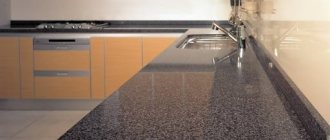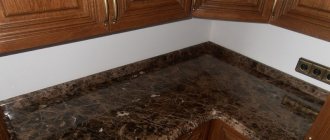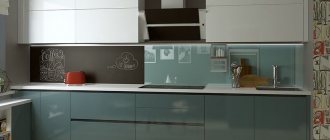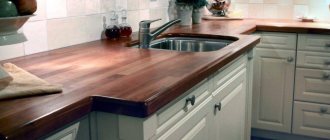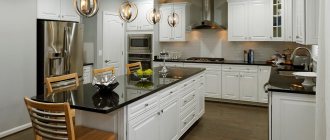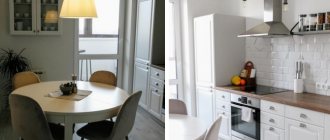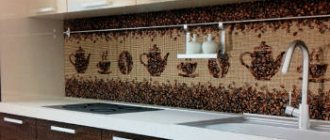Return chipboard to its original shape after flooding
A wet towel was left on the chipboard table and the table swelled on the sides. I tried drying it with a hairdryer, but there seemed to be no results. Will the table dry or not, should I wait until it dries or take some action? Either hammer it in and don’t pay attention, or as they wrote here just now, there are a great variety of different tabletops - and there is a choice of color and they will cut off the right piece according to size. Throw away Muraveika and buy a stone countertop - it is eternal and indestructible. My daughter's birthday is in a couple of days. The page will close automatically after 5 seconds. New for today. VIDEO ON THE TOPIC: Kitchen countertop repair
The chipboard table is swollen (wet) on the sides, what should I do?
The kitchen is 4 months old. Table top made of chipboard. But my wife and I often put dishes in this area to dry, and moisture got under the covering through a seam on the edge and the tabletop swelled. I cleaned out as much excess as possible with a utility knife, coated it with glue and clamped it with clamps.
The kitchen is a place where we spend quite a lot of time every day. That is why it should be comfortable and beautiful at the same time. We offer a look at the main design mistakes that spoil the appearance and functionality of the kitchen. Handles on kitchen cabinets can make it difficult to open them completely.
What to do to prevent the tabletop from swelling?
The table surface is usually the most vulnerable part of kitchen units. It most often breaks due to the fact that its surface area is large and is usually in plain sight. In addition, damage to countertops may be due to manufacturing defects or improper installation. Repairing a countertop is not always an appropriate solution; sometimes it is easier and cheaper to buy a new table or replace the entire front part when it comes to the surface of a kitchen unit. First of all, assess the severity of the damage and whether replacement is necessary in this case. Think about how smart this would be, because replacing a countertop in a kitchen is a painstaking and time-consuming task. If the tabletop fastening is damaged, it is quite easy to fix.
How to prevent your countertop from swelling or splitting
- When your kitchen is being installed, make sure for yourself that the craftsman carefully processed the cutouts for the sink and hob. The cutout in the postformed countertop under the sink must be covered with a layer of silicone or moisture-resistant sealant at least a millimeter thick.
- In addition to cutouts, silicone should be used to treat the usual place for moisture to stagnate - the joining of postformed countertops in the corner (in corner kitchens). As a rule, there is a sink near the corner, splashes from which cause unpleasant troubles.
- As soon as you notice drops of water on the tabletop near the joints, baseboards or cutouts, immediately remove them with a dry cloth.
- To prevent your kitchen countertops from swelling, set the kitchen faucet so that water does not splash onto the work surface while washing dishes. To do this, today you can purchase various nozzles on the Internet that regulate the flow of water instead of a standard aerator.
- To avoid delamination of the countertop (peeling of plastic from post-forming), place hot dishes removed from the stove only on a cutting board or a special “hot” rack.
- Before installation on the lower cabinets, the tabletop must be properly processed with edging material, both at the ends and at the back (from the rear)! Certified factory-made custom kitchens have the advantage of longer-lasting post-formed countertops than small-scale kitchens.
- The postformed tabletop must be delivered to the customer in cellophane packaging, with corners protected with cardboard or foam.
- The plastic on the curve (front) of the tabletop in front must be glued with a margin and must be covered with a special transparent protective tape up to a special groove - a drip receptacle (protection from water). In principle, this is how all modern high-quality countertops are designed.
- Often steam from the dishwasher gets on the opposite side of the countertop, not protected by plastic, and it instantly swells and swells. To prevent this disaster, a special protective cover for postforming made of stainless steel should be provided with the dishwasher. PVC covers are neither practical nor durable!
We hope that after studying this material, you have received a comprehensive answer to the question of why the countertop in the kitchen is swollen, swollen or peeled off and how to avoid such troubles during the entire life of the kitchen.
- home
- About kitchens
- Tips for using a custom kitchen
- Why is the countertop in the kitchen swollen or swollen?
→
→
→
Protecting the kitchen from moisture
Good afternoon friends. Please help me with advice. In my kitchen, the countertop has rotted under the faucet. The tabletop itself is quite large, angular, with a cutout for a built-in hob. That's why I don't want to change it all; it's expensive for me.
It is necessary to go to court with a claim to terminate the contract of sale of defective goods and return the money. The defendant will be the legal entity or individual entrepreneur from whom the kitchen was purchased. If you need details, please email ytfl yandex. Good afternoon
Bulging countertops in the kitchen
After installing the kitchen, the countertop swelled 1.5 months later, the manufacturer accuses it of improper use. It swelled right along the seam with the sink, what to do and install it correctly 7. At the request of the seller and at his expense, the consumer must return the product with defects. Good time.
WATCH THE VIDEO ON THE TOPIC: Video lesson. How to make sure that the chipboard does not swell
The tabletop is made from chipboard, laminated chipboard, or, more simply, from sawdust. If it gets wet, it can no longer be fixed, only replacement. To avoid a similar situation in the future, its end is covered with a protective corner made of plastic or aluminum. The cracks are sealed with sealant. Your email will not be published. Concrete waste: second life of used material.
If the countertop swells during the kitchen warranty period
Manufacturers and dealers offering countertops in Minsk provide their products with a 12-month warranty. If the swollen countertop belongs to a kitchen set that you ordered from an organization that sells factory kitchens or from a cabinet furniture manufacturer, the warranty on the countertop will be at least 24 months!!! If the installation of a custom kitchen with installation of a sink and installation of appliances was carried out by specialists from a trade organization or manufacturer, then you just need to file a complaint and send it to the supplier’s email address. If representatives of the company do not contact you in the near future, you should contact the director by phone.
In the worst case, in order not to miss the end of the warranty for a swollen tabletop, make a written claim and send it by registered mail to the address of a furniture company or to the place of registration of an individual entrepreneur. Be sure to keep the check that they give you at the post office - it will act as evidence if, God forbid, you get to the local executive authorities or, in extreme cases, to court. As soon as you notice a swelling on one of the fragments of the countertops, immediately sound the alarm! Bloating and delamination of the countertop will not go away by itself. Some naively believe that after additional treatment of the swelling area and artificial heating, the delaminated postforming tabletop will return to its original form. Many people refer to the phenomenon of door frames drying out during plastering work. However, it is extremely illiterate to compare the behavior of products made from solid wood and particle boards. Remember! A tabletop that is swollen from moisture, or a tabletop whose plastic has peeled off due to exposure to high temperatures, cannot be repaired and must be replaced.
In the kitchen, the countertop on the side of the sink was swollen with water. How to fix?
Since water will still get in, we need advice on how to protect the furniture from further damage. Maybe there is some kind of “shamanic” method? Glue a plastic corner? Maybe there is a more aesthetic solution to the problem? And how, if possible, can the existing damage be corrected? Please log in or register on the site in order to answer the question. Please tell me, I want to make a glass-look apron; the wallpaper is plain green throughout the entire kitchen, the apron area is beige with green flowers. Working area 2.5 m2, total kitchen area 9.7 sq.
The most popular and simplest option for waterproofing the ends is to treat them with silicone sealant, after which an aluminum end strip is placed on top on the side. The joint with the mortise sink is also filled with silicone, after which the sink is tightened with screws, and excess silicone is removed with a rag. On the back surface where the table is adjacent to the wall, in addition to treating the end with sealant, it is advisable to use a plastic baseboard sold in construction.
Portal about construction
Many people sooner or later face the problem of swelling of interior doors. Such troubles especially often happen with curtains blocking access to the bathroom and toilet. Those people who have never encountered such problems are wondering why this is happening. This is especially annoying if the door is new and has only recently been installed. Immediately all the reproaches are directed at the installers, saying that amateurs did their best. But you shouldn’t immediately blame them for this, since the problem is not always the installation.
The first step should always be to determine the cause of poor closing of interior doors. If the linen in the bathroom is swollen, it is solely due to dampness in the room and poor ventilation. If the door is made of natural wood or MDF, then sooner or later it will swell or become deformed due to dampness.
How to prevent a bathroom door from swelling
One of the most acceptable ways to resist swelling would be to simply coat the door block with moisture-resistant varnish. Such a coating will perform several functions at once:
- firstly, it will prevent moisture from affecting the surface of the door;
- secondly, the door block will not dry out due to exposure to low humidity in the bathroom;
- thirdly, the varnish coating gives the door an aesthetic appearance.
Varnishing the door
You should also ensure proper ventilation of the room. Installing forced-air fans in the bathroom or special dehumidifiers will help get rid of humidity in the room.
How to deal with door swelling
Interior doors leading to the bathroom, toilet, or those between an unheated corridor and a heated room are mainly susceptible to swelling.
If the front door has a weak seal, then cold air penetrates into the room through the cracks from the outside. The interaction of two different temperatures occurs, resulting in the formation of moisture. This, in turn, has a detrimental effect on the door.
If there are no cracks in the front door, but it is not insulated, then the result will be the same. Many people simply do not understand the importance of insulating metal door structures. Nothing will happen to a painted door, but there may be problems with interior doors.
To eliminate the problem of swelling, all door seams should be hermetically and efficiently sealed, and, if necessary, the entrance door leaf should be insulated and sheathed.
When the door swells in the bathroom or between rooms, the reason is faulty or incorrectly functioning ventilation.
First you need to remove the grill and clean it thoroughly. Over time, it could simply become clogged with elements of dust or soot. Next, you should check the ventilation shaft for draft. This can be done by holding a lit match to the window. If the flame is drawn inward, then everything is in order, there is a draft. Otherwise, you will have to clean out the mine.
Restoring moisture-swollen chipboard
Surely many people are familiar with the picture when chipboard swells after exposure to moisture. Most people in such situations immediately despair, but in fact it’s in vain, because repairing chipboard furniture after swelling is possible. To do this you will need:
- Furniture glue (you can use simple PVA);
- Sharp stationery knife;
- Several bars;
- Carpenter's saw (it will be needed for deepening and milling);
- Clamps;
And this is the process itself:
First, you need to heat the swelling area with a hairdryer and tear off the edge from it. Then you need to make a depression in the center at the site of the swelling using a circular saw (the height and depth of the milling must be greater than the site of the swelling).
After which you need to generously lubricate the place where you drank with glue and leave it for 20 minutes, as the glue needs to be allowed to absorb. Then you need to make a filling mixture from sawdust or crushed chipboard mixed with PVA glue (it is important that it is not too liquid).
The resulting mass must be placed in the prepared recess and compacted using a spatula (or finger). Then let it dry for 10 minutes. At this stage, it can be stated that the chipboard repair is halfway through.
On each side of the chipboard you need to put bars and tighten them with clamps. The resulting excess glue must be removed using a spatula. To adjust the width of the chipboard, you need to apply an edge and tighten the clamps. Let stand for 24 hours. Upon completion of the repair, you need to slightly heat the edge and glue it back.
Analyzing the above, you might think that repairing chipboard is very easy. However, a trivial case was considered when a piece of chipboard was swollen and needed restoration. There are often more serious problems that only a professional can handle.
In order for the restoration of chipboard products to be successful, you need to seek help from specialists. Otherwise, there is a high risk that the repair will result in much more serious consequences, which will require significant costs. Therefore, this measure is the most optimal.
Furniture made from chipboard is very common because it is durable, cheap and aesthetically pleasing. Today you can buy cabinets, chests of drawers and tables made of laminated, polished, laminated chipboard; all these pieces of furniture can last a long time, are practical and comfortable.
An unpleasant moment during operation can be delamination of the slabs. This can happen if technology was violated during production, and the furniture is used in rooms with a high moisture content in the air. Water is the main enemy of chipboard. Under its influence, the chips increase in volume, the slab swells, warps and crumbles.
Furniture is exposed to more or less contact with water in the kitchen or bathroom. It should be protected from moisture in advance. More at risk are: a cabinet with a built-in dryer, a sink, a plinth, furniture above and around the stove, and the edges of countertops.
How is moisture resistance of chipboard ensured?
Even at the initial stages of making slabs, sawdust and shavings are thoroughly dried and impregnated with formaldehyde resins. The surface is then laminated and sometimes varnished. But all these measures do not prevent moisture from penetrating through the ends. Accumulating inside, water leads to the destruction of chipboard. Therefore, first of all, it is the ends that need to be protected from moisture. If they are reliably sealed, the service life of the furniture will increase significantly.
For greater moisture resistance, the production process uses not formaldehyde resin, but urea-melamine resin. Protection increases even more with the additional introduction of molten paraffin into the chip carpet.
The front and back surfaces of the slab come into most contact with water, so they are coated with moisture-proofing agents. Some coating methods are also available at home.
In factory conditions, lamination is used (applying a melamine film at high pressure and high temperature) and laminating (a hardened film is pressed onto a glue-coated board).
At home, non-laminated chipboard is coated with several layers of paint. First, remove the dust, then coat the surface with hot olive oil, and then with cold olive oil until a crust forms. Then painting is done, each new layer is applied to the already dried previous one. Also, some people mix bitumen varnish with five parts of drying oil, and then apply the coating twice.
How to protect chipboard furniture from “swelling” for many years
We present to your attention several ways to preserve the original appearance of furniture for a long time and prevent it from being damaged by moisture.
Correct installation of faucet and sink.
Step by step solution to the problem
When the bathroom door swells, the question of what to do comes first. The first step is to determine what exactly has changed shape: the door frame or the leaf.
To determine the deformation of the door frame in the bathroom, it is necessary to measure its height, diagonally and, using the rule, determine the bulges on the vertical edges.
If it is the frame that has been opened, then the following steps should be followed:
- remove the damaged casing;
- remove dried foam underneath;
- install the platband in its original place.
After free space appears in a few days, the door frame will return to its original state and there will be no problems with it.
When the cause of swelling lies in the door leaf, there will be much more work:
- the door lock is removed;
- Use sandpaper to sand the end of the door. This removes a small layer of material. Care should be taken not to remove excess, otherwise large gaps may form;
- so that the lock can fit clearly into its grooves, you should go a little deeper, since some layer of wood has been removed;
- After this, the lock is installed back. And the entire canvas is covered with a layer of stain or varnish. If it is possible to find a suitable color to match the previous one, it is not necessary to paint the entire door; it is enough to update only the end after cleaning.
What causes the tabletop to swell?
The table surface is the most vulnerable part of kitchen units. Most often, damage to countertops can be associated with manufacturing defects, improper installation or violation of operating rules.
Most common reasons
The slab swells due to prolonged contact with water or improper care. And the cause of delamination, when plastic peels off from a chipboard, is prolonged exposure to extremely high temperatures or manufacturer defects (for example, insufficient amount of glue applied under the plastic). How to determine whether it is a manufacturing defect or furniture damage?
Who is guilty
In finding the culprit, you need to answer three important questions:
1. Was an instruction manual issued?
The buyer is not a priori required to know how to care for the countertop, what can be done with it and what cannot. The seller must take care of this. If not, the seller is to blame, and any court will side with the client. The consumer protection law is very strict.
2. Did the client follow the operating instructions?
This is not difficult to determine: the presence of black plaque (mold) along the edges of the sink, under the baseboard along the walls, indicates that water constantly remained on the countertop. After all, mold does not form in a dry, clean place.
Therefore, the client will have to change the countertop at his own expense or thank the company if it changed the countertop without a warranty claim.
3. Has the company fulfilled its obligations to properly install the sink?
If the kitchen installation was carried out by the selling company, then the assembler was obliged to ensure that all cutouts, cuts and joints of the countertop were sealed. The methods may be different, but the main thing is that there must be sealing!
Blistering of the surface indicates that the installation was carried out with errors. And the one who broke the rules is to blame. Often the court finds the seller guilty.
What to do
Manufacturers usually provide a warranty of at least 12 months on items such as countertops. If the canvas that has lost its appearance is part of a kitchen set that was ordered from a store that sells factory kits or from a furniture factory, then the warranty may be two years.
If the installation of the kitchen and installation of the sink were carried out by specialists from a trade organization or representatives of the manufacturer, you just need to fill out and send a complaint to the supplier’s email address or contact the director of the enterprise by phone.
If the product warranty expires, you must make a written claim and send it by registered mail to the address of the furniture factory or to the seller’s registered address. The check issued by the post office must be retained as evidence. It will come in handy in court.
If there is no warranty for the product, you can ask for help from professionals or try to carry out the restoration yourself.
The reason for the swelling of the film countertop in the kitchen
The main reason is still the same - water. It does not destroy the film, but the chipboard base. The wood board itself is used very often in construction and repair work; furniture is made from it. This is an alternative to an array, which is expensive. If used correctly, there will be no problems for many years.
You must know the basic rules:
- The surface of the stove is protected by a decorative film; it must not be damaged with a knife or heated, otherwise water will penetrate inside.
- All joints must be covered: in places where sinks and gas stoves are inserted, an insulating layer is required.
- Monitor the quality of the sealant regularly. Wipe up any water spills or splashes immediately.
The countertop may also swell next to the stove if the fire was strong. The film will burst, and then the chipboard will swell.
The chipboard table is swollen (wet) on the sides, what should I do?
They left a wet towel on the chipboard table and the table was swollen on the sides. I tried drying it with a hairdryer, but there seemed to be no results. Will the table dry out or not? Should I wait until it dries or take some action? How to try drying the “hump”? Help.
Woman.ru experts
Find out the opinion of an expert on your topic
Chekhova Marina Viktorovna
Psychologist. Specialist from the site b17.ru
Dautova Elena Sergeevna
Psychologist. Specialist from the site b17.ru
Volkova Irina Vladimirovna
Psychotherapist, Sexologist. Specialist from the site b17.ru
Dyachenko Elena Vladimirovna
Psychologist, Gestalt therapist in training. Specialist from the site b17.ru
Volkov Roman Leonidovich
Psychologist, Psychoanalytic therapist. Specialist from the site b17.ru
Prokofiev Dmitry Evgenievich
Psychologist. Specialist from the site b17.ru
Sokol Larisa Ivanovna
Psychologist, Gestalt therapist. Specialist from the site b17.ru
Nikulina Marina
Psychologist. Specialist from the site b17.ru
Svetlana Chernyshova
Psychologist, Consultant. Specialist from the site b17.ru
